09 September 2025
660
25 min
5.00
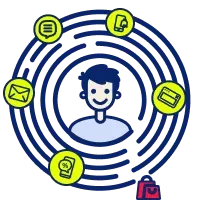
Mastering Omnichannel: A Guide to Tools, Strategy, and Ecommerce Case Studies
Content
Customers have changed. They no longer move linearly from advertising to purchase. Instead, they expect one thing: a holistic, logical, and personal customer experience.
Today, the customer journey is better visualized as a spiral—a sequence of dozens of touchpoints: social media ads, website browsing, emails, shopping, marketplace reviews, and more.
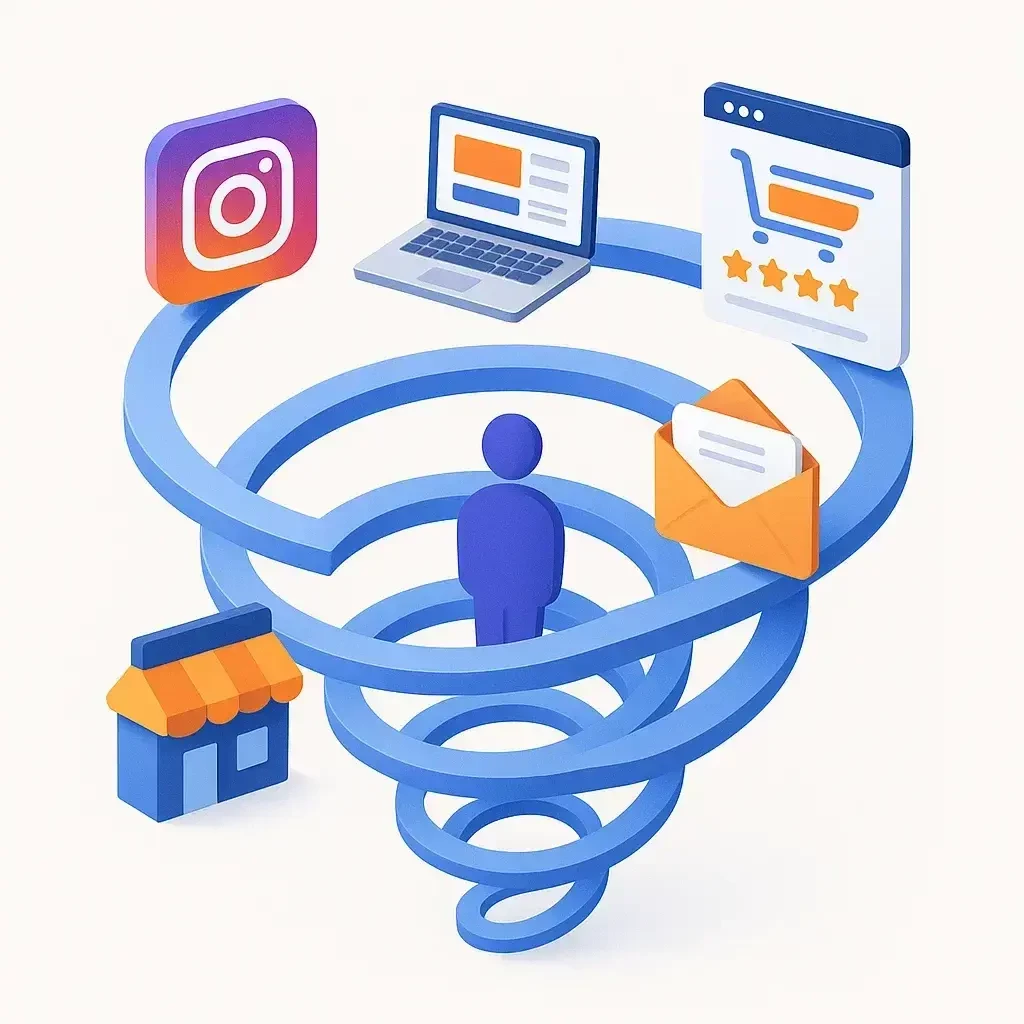
Businesses that fail to create coherent, consistent communication at every stage risk losing customers long before a purchase decision is made. Research confirms this:
- 75% of customers expect a seamless experience across all channels, yet only 25% believe brands actually deliver it;
- сompanies that have adopted omnichannel strategies report 5–15% revenue growth;
- сustomers who enjoy a high-quality omnichannel experience are 3.6 times more likely to make repeat purchases and deliver 1.6 times higher CLV (customer lifetime value).
Next, we’ll explore how omnichannel differs from other approaches, how modern companies implement it, and what steps you can take to turn it into a fundamental driver of business growth.
What is Omnichannel Marketing
Omnichannel is an approach designed to create a seamless customer experience. Every channel works together, shares real-time data, and adapts to user behavior, so each new message feels like a natural continuation of the previous one rather than a broken interaction or a forgotten history.
Omnichannel marketing isn’t about the number of channels. It’s about how well they work together.
When someone moves from an email to a mobile app, from a website to a physical store, they expect the brand to recognize their journey. They don’t want to search for the same product again, re-enter their details, or repeat the question they’ve already asked.
Multi vs. Cross vs. Omnichannel: How Not to Get Confused
At first glance, they may look like just different prefixes of the same word. In reality, they represent three distinct approaches to working with customers.
Important
In marketing, multi-, cross-, and omnichannel are often confused because all three involve multiple communication channels. However, the key difference lies not in the number of channels but in the level of integration—how these channels work together or whether they work together at all.
A business that calls itself omnichannel but still follows a multichannel logic may see some results, but far fewer than it could.
To achieve proper consistency in communication, you need a system that unifies data and tools. A CDP (Customer Data Platform) does exactly that: it builds a single customer profile and powers segmentation, personalization, and automated campaigns.
Want to jump right into true omnichannel?
Let’s analyze the differences between all approaches using the cases.
Multichannel Experience
Imagine Anna. She’s scrolling through her Instagram feed and comes across a beautiful shoe ad—lightweight loafers, which are exactly her style. Even better, they’re on sale. She clicks through the website, browses a few models, and saves the page.
The next day, Anna receives an email from the same brand with discounts on completely different products. A week later, she visits their offline store, only to find none of the items she saw in the ad. The salesperson doesn’t even know what promotion she’s talking about.
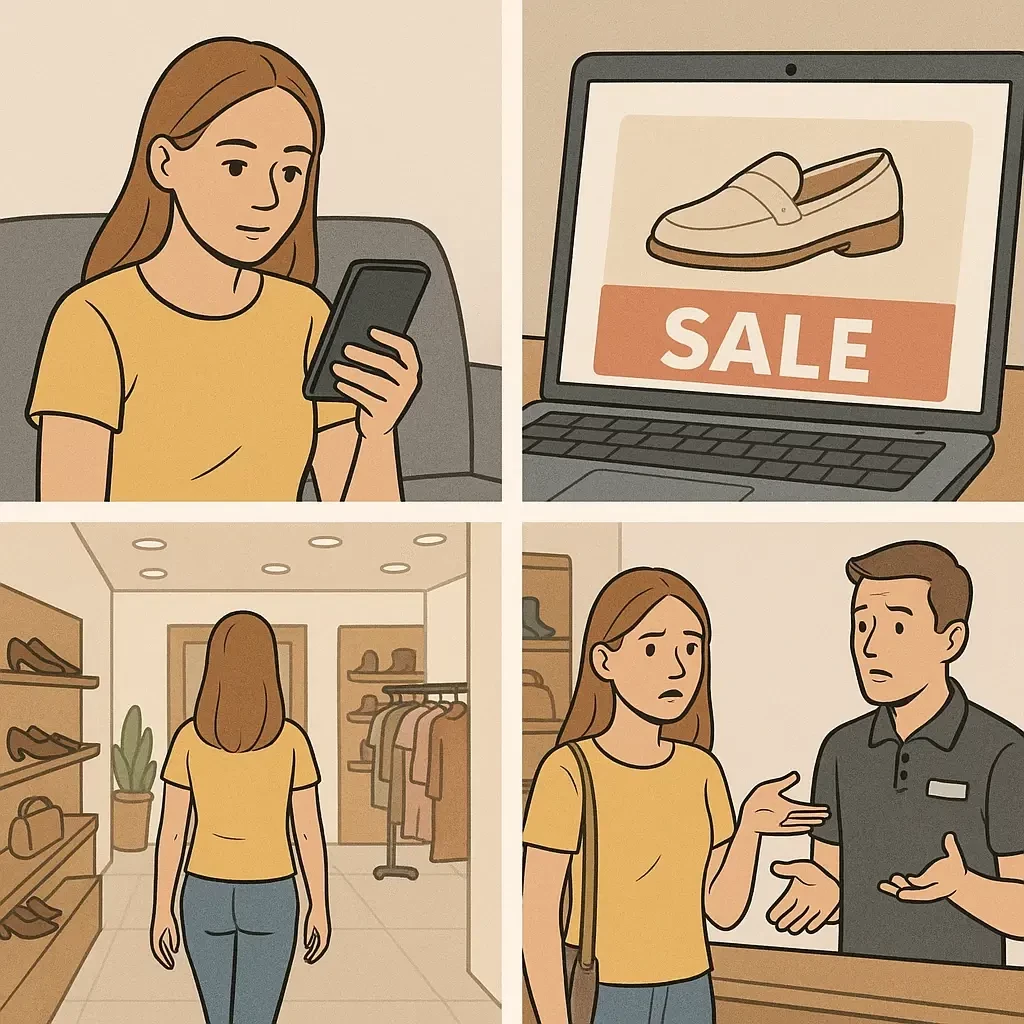
This is multichannel: the channels exist, but they’re not connected.
For a marketer, this means:
- data from one channel isn’t carried over to another;
- it’s impossible to track the whole customer journey;
- personalization is limited to isolated campaigns.
Each communication starts from scratch, with no continuity or context. Managing the customer experience and building effective workflows becomes difficult: neither triggers nor segmentation work to their full potential.
Multichannel is the first step toward large-scale communication. It’s better than nothing, but customers drop out of the interaction before they even intend to buy. Not because they aren’t interested—but because the brand hasn’t created conditions where that interest can turn into action.
Cross-channel Experience
Anna spots an ad again—this time it’s a pair of sneakers that perfectly match her dream athleisure look. She clicks through to the website, opens the product page, adds the sneakers to her cart… but doesn’t complete the purchase—she has to rush to a meeting.
A few hours later, she receives an email: “Your pair is still waiting in your cart.” It feels nice—the brand is staying in touch.
The next morning, Anna opens the mobile app, but all she sees are other products, a generic banner, and no mention of her choice. A few minutes later, a push notification pops up: “15% off on shoes.” Pleasant, of course—but she was browsing sneakers.
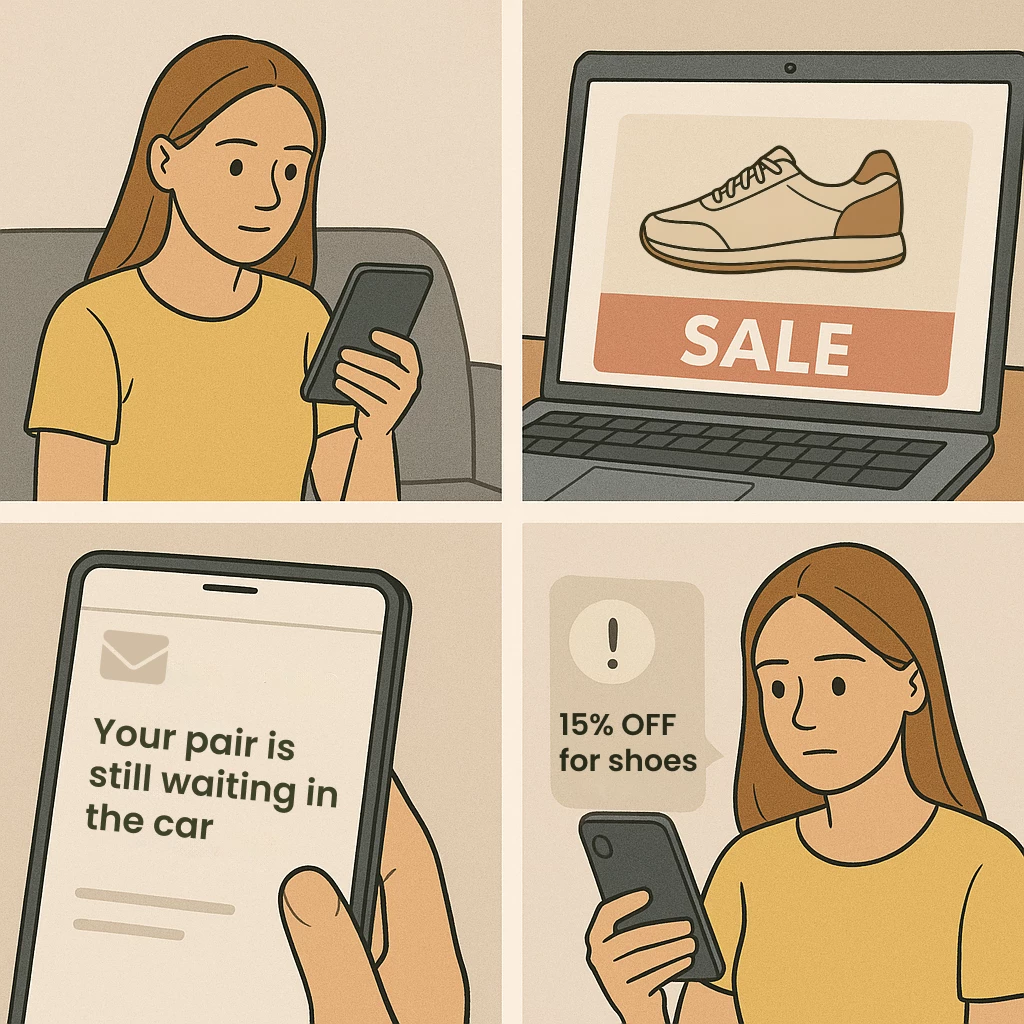
Channels are partially connected. There is a reaction to specific actions, such as an abandoned cart. But the overall experience logic still falls apart: the brand remembers one thing while ignoring another.
For marketers, this brings progress, but it is limited:
- some data is captured automatically, but not all;
- messages from different channels are poorly coordinated;
- scaling triggers is complicated due to a lack of understanding of customer actions and journeys.
Marketing tools are partially integrated, but there is no unified customer profile. As a result, team workload increases, duplications arise, and there is a risk of outdated personalization.
Cross-channel is a step forward compared to multi-channel. But without a centralized data system, it remains fragmented: campaigns work, but not as a single whole.
Omnichannel Experience
This time, things are different.
After Anna adds a pair of sneakers to her cart, she receives not just a reminder, but a personalized email with a discount for this particular model. At the same time, she gets a mobile push notification with the same offer and a call to take advantage of it. Anna opens the app and completes the purchase there.
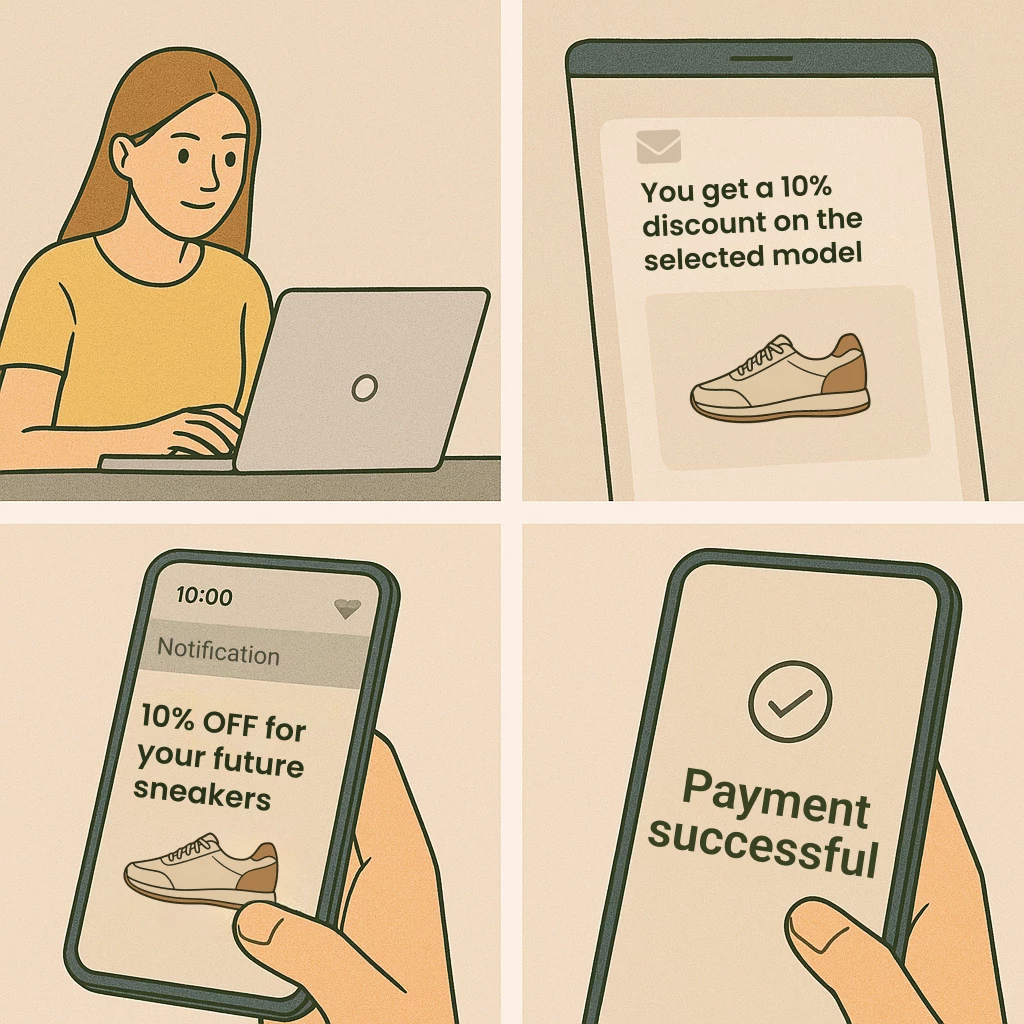
Over time, the brand noticed that most customers interact with the mobile app rather than the website. From then on, it adapts its communication: new offers arrive via mobile push, App Inbox, and In-App messages—personalized, timely, and in a format convenient for Anna.
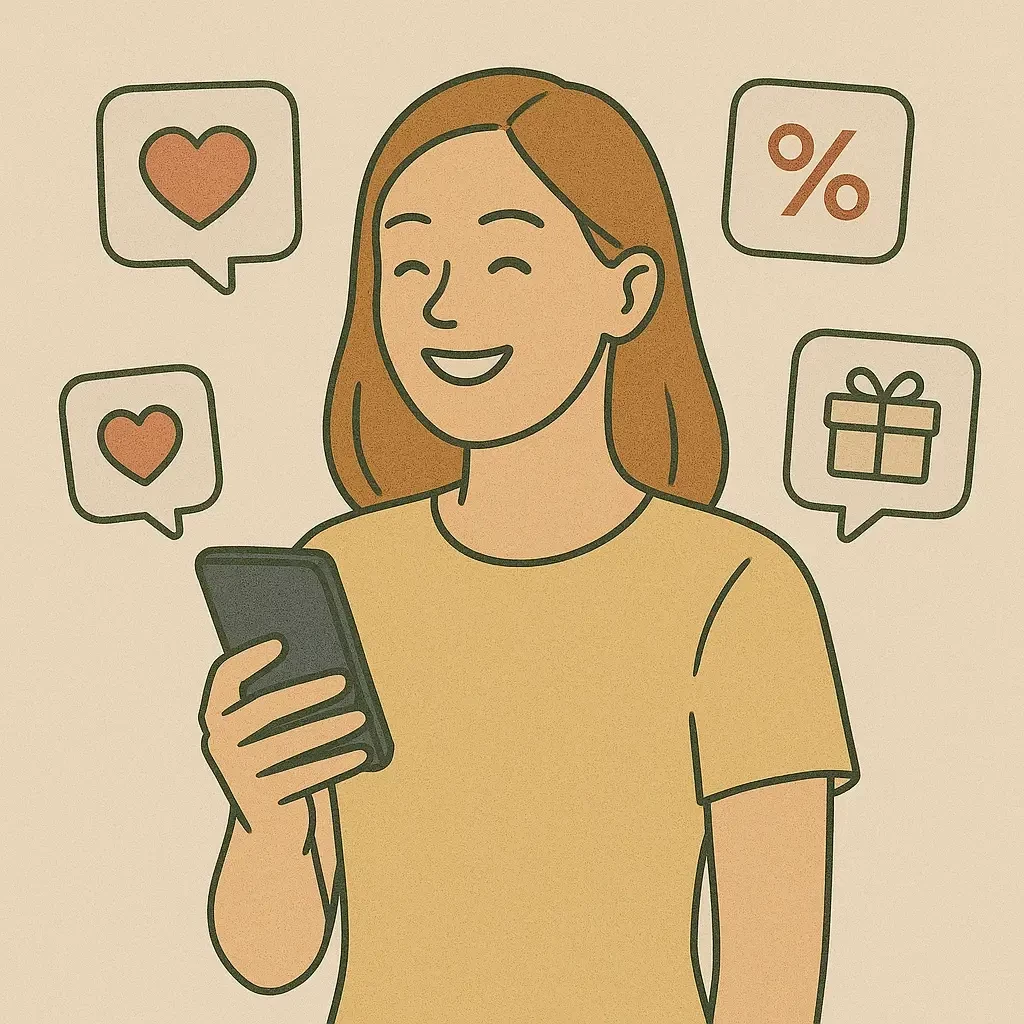
Now the communication is consistent: each channel knows what has already happened and picks up the customer without repetition.
For marketers, this means:
- a clear understanding of how the customer moves between channels;
- a unified environment for working with data, segments, and campaigns;
- the ability to scale workflows without losing context;
- personalization based on actual user behavior, not just profile data.
Workflows are automated, data is accessible without complex integrations, and the team works in a system that adapts to each customer.
Omnichannel is not about the number of channels. It’s about consistency, controllability, and effectiveness.
Start setting up your own omnichannel workflow
To better understand the difference in approaches, let’s summarize them in a comparative table.
Here’s the table translated to English:
| Criteria | Multichannel | Cross-channel | Omnichannel |
| Channel Interaction | Channels operate separately, without synchronization | Channels operate separately, without synchronization |
All channels are unified, and data is transmitted in real time |
| Customer Experience | Fragmented, the user starts from scratch in each channel | More consistent, but not holistic—logic can be disrupted |
Unified and seamless experience—each channel picks up from the previous one |
| Personalization | Minimal or absent | Basic reaction to user actions |
Dynamic, personalized in real time |
| Example with Anna | Email doesn’t match the actual interest; the offline store doesn’t know about the promotion the user saw | There’s an abandoned cart email, but the app and mobile push don’t account for previous activity | Email and mobile push are coordinated; the brand considers that the client uses the app and continues to communicate there consistently and personally |
Turning Omnichannel into Growth: Practical Takeaways
Everything we do in marketing ultimately boils down to one thing: results that have business value.
Revenue growth, cost reduction, customer retention, and process automation are not separate goals but parts of the same system of effective retention. Let’s examine how an omnichannel approach helps to achieve each of them.
1. Automating Processes and Cutting Manual Work
Thanks to automated workflows that respond to user behavior, marketing can be scaled without involving additional resources. This is especially relevant for companies aiming to launch processes quickly without compromising interaction quality.
At Le Gourmet, key workflows were set up in just 40 hours—abandoned cart, welcome series, order confirmation, and more—with minimal team involvement. The marketer defined the conditions, and the system executed them: what to show, when, and to whom. This made the launch of basic campaigns fully automated.
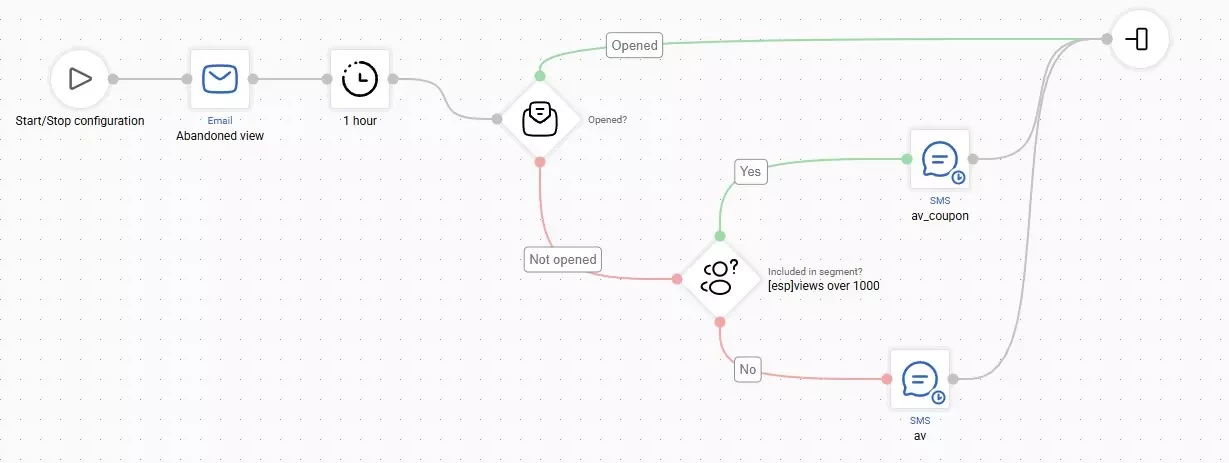

Dmytro Verba, Owner of Le Gourmet
“Last year, we finally decided to implement email marketing, and now I can confidently say we shouldn’t have waited so long. After a thorough search and analysis of services, I chose Yespo and am completely satisfied with the quality of services and the team’s support. At this point, we are increasing the number of campaigns. Customer loyalty and engagement have grown by up to 30%.”
Launch automated campaigns in 40 hours like Le Gourmet
2. Boosting Conversion
Communication must be delivered on time and through a convenient channel to drive action. An omnichannel system provides exactly this—workflows adapt to customer behavior.
A Ukrainian pet store saw positive results from this approach, where email, Viber, and web push became part of a single workflow.
If customers didn’t complete an action on the website, they received reminders across multiple touchpoints, considering what they were searching for, buying, or selecting previously. By the second month after launching the new triggers, conversion in Viber messages had increased tenfold.
3. Average Order Growth
Omnichannel allows companies to regain customer attention and increase the value of each order, thanks to personalized selections and precise timing.
This is what “TehnoYizhak” did. In addition to traditional email marketing, the company added App Inbox. This channel does not require user consent for notifications and delivers messages directly to the personal account on the website and in the app. This made it possible to reach an additional touchpoint and make communication instant.
Result: the average order value in App Inbox trigger messages was almost 5% higher than in email, and in promo messages, 5.5% higher.
Add App Inbox to your triggers
4. Customer Retention and Value Growth
Acquiring new customers costs a business five times more than retaining existing ones.
People stay with brands that understand their needs and offer relevant solutions.
Omnichannel allows acting proactively, considering the customer’s interests, stage, and value. For example, VARUS implemented RFM segmentation, set up personalized workflows for each customer group, and launched an omnichannel welcome campaign.
New contacts received emails, Viber messages, and SMS with discounts on their first orders, explanations of service benefits, and a survey to collect data. Loyal customers received relevant news and attractive offers, while former customers were sent personalized discounts, a promo code for free delivery, and gifts with their order.
The focus was on segments with potential for repeat interaction, and workflows were built specifically for them. The result: the campaign returned more than tenfold—every invested hryvnia generated 10.73 hryvnias in revenue. This strategy helped retain and reactivate customers and increased the interest of new ones—even at the initial stage of brand engagement.
Omnichannel brings customers back and builds long-term interaction value. Instead of focusing solely on the first purchase, the business creates a system that encourages repeat orders and increases Customer Lifetime Value (CLV).
Reduce customer churn this month
At the heart of this interaction is personalization. It is what helps a brand not only be present, but also relevant. If the system knows that a customer buys medium-sized dog food every 40 days, it will remind them immediately. If a user always chooses a particular electronics brand, that same brand will be recommended when new products arrive. This creates the feeling that the brand understands, remembers, and cares.
Both CLV and loyalty increase. Customers return because it’s convenient and beneficial for them. Meanwhile, the brand invests in growth rather than endlessly acquiring new consumers.
5. Cost Optimization and ROMI Growth
The better a brand knows its customers, the smarter it spends its money. Omnichannel directs communication to where it will be effective—taking into account user actions, channel preferences, and purchase history.
Zootovary.com сase: in addition to mass and trigger email campaigns, the brand added the App Inbox channel. This strengthened existing workflows, reached a wider audience, and better captured users’ attention.
As a result, profit from retention communications increased by 28.4%, and every invested hryvnia generated an additional 74 UAH in revenue.
A similar approach worked for Dnipro-M. Thanks to the integration of App Inbox, personalized recommendations, and omnichannel triggers, the brand not only enhanced customer interaction but also recorded growth in key metrics within the first month after launch.
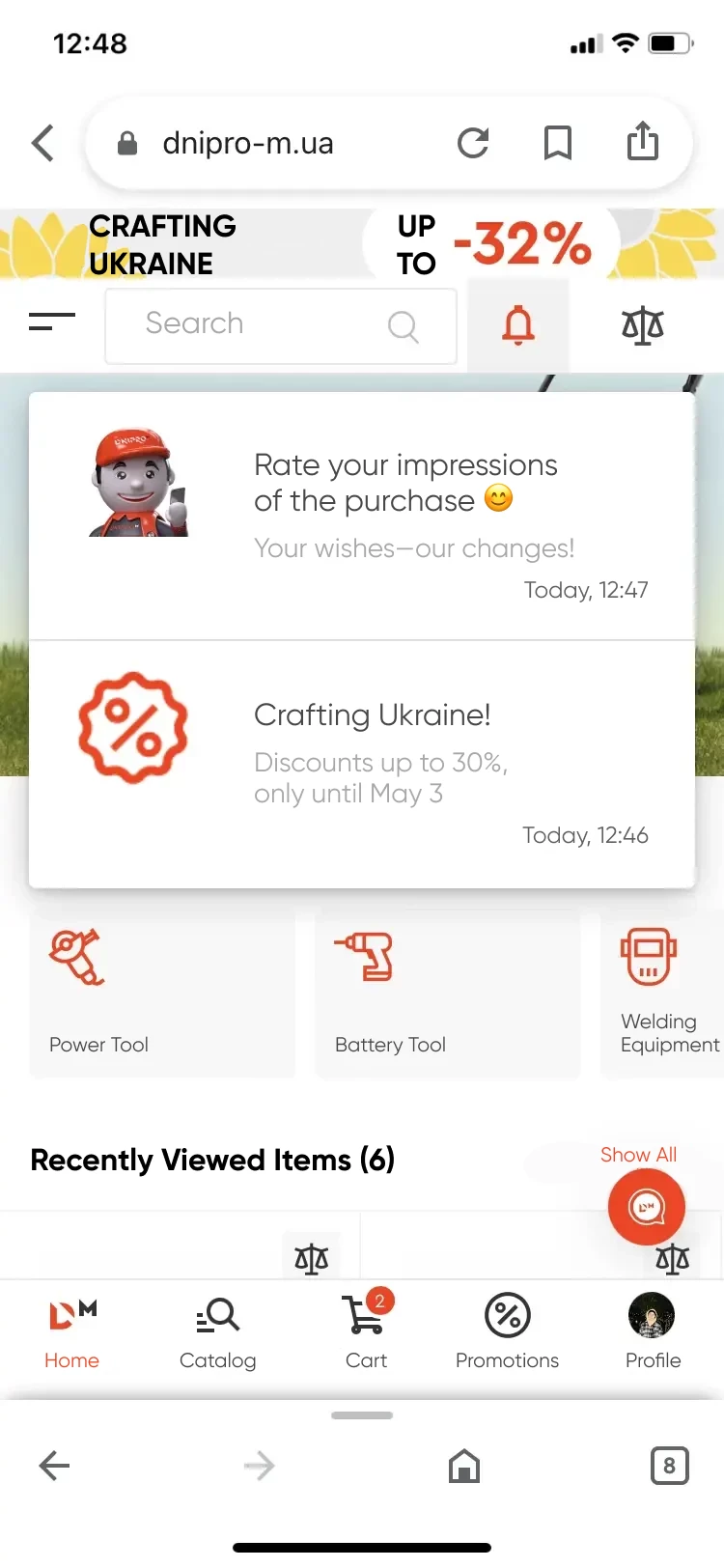
The share of orders from triggers increased multiple times, and the ROI of product recommendations grew by 23.5%. Overall payback from communications using the Professional plan increased 11-fold.
This is how O.TAJE did: Viber remained a communication channel, but only for users with a high likelihood of purchase.
Using predictive segmentation, the brand targeted the audience with the highest potential and avoided spending on random impressions. Result: campaigns generated revenue ten times higher than the costs, and ROMI increased by +310% compared to traditional approaches.

Alex Danchenko, Yespo Chief Operating Officer
“Omnichannel is not just for big players. Smaller teams can also benefit from it if they act strategically. Sometimes, adding one or two additional channels, such as App Inbox or messenger, to see results is enough. It all depends on how you use them. Predictive segmentation helps you focus on those truly ready to engage, rather than wasting resources on everyone.”
6. Data-Driven Decision Making
Customer behavior in emails, messengers, the app, and on the website is not a set of isolated actions, but a single picture that helps the brand act confidently. Data collected from different channels allows moving from intuition to evidence-based decisions.
Which formats work best in Viber? When should an email be sent to maximize Open Rate? Which segment responds best to personalized offers? Answers to these questions come not from the omnichannel approach but from analytics within the system: A/B tests, behavioral reports, and dynamic segmentation.
Analytics in an omnichannel system allows us to see not only what works but also to understand why. Based on this data, a strategy is formed where every decision is supported by customer behavior:
- channels do not compete, but work in coordination;
- workflows are not imposed, but appropriately capture interest;
- the budget is not scattered, but invested in what delivers results.
7. Strengthening Existing Marketing Solutions
New channels are not always necessary to scale. Sometimes, it’s enough to rethink and combine existing tools into a coordinated system.
This was the approach taken by the Ukrainian brand Natali Bolgar. In 2023, the company already had fundamental triggers: transactional messages, birthday greetings, and a “Promo Code for Subscription.” The next step was implementing a full-fledged omnichannel system based on the Yespo Professional plan.
The team set up 13 workflows that responded to user actions, such as abandoned carts and views, out-of-stock products, discounts, and new arrivals.
Importantly, communication was not just automated—it adapted to the situation. Email was used as the main channel, while Viber was triggered only when necessary to regain the customer’s attention quickly.
Result: revenue from trigger messages increased by 650% in just 4 months.
How Omnichannel Works from the Inside
From the outside, it all looks simple: the user receives a message through a convenient channel, sees a personalized offer, and easily returns to the selected product. But behind this is a flexible, coordinated system that adapts to people’s actions every second.
This section will explore how it works and which channels and tools it includes.
CDP as the Basis of a Coherent System
In each case of Ukrainian companies mentioned above, there is a common feature—communication works as a single whole. This is made possible by a CDP—a platform that unites data, channels, and workflows.
It collects information from all touchpoints—website, app, email, messengers, CRM, offline locations, and more—and forms a unified customer profile. This profile contains everything: purchases, interests, responses to campaigns, website behavior, favorite products, and preferred channels of interaction.
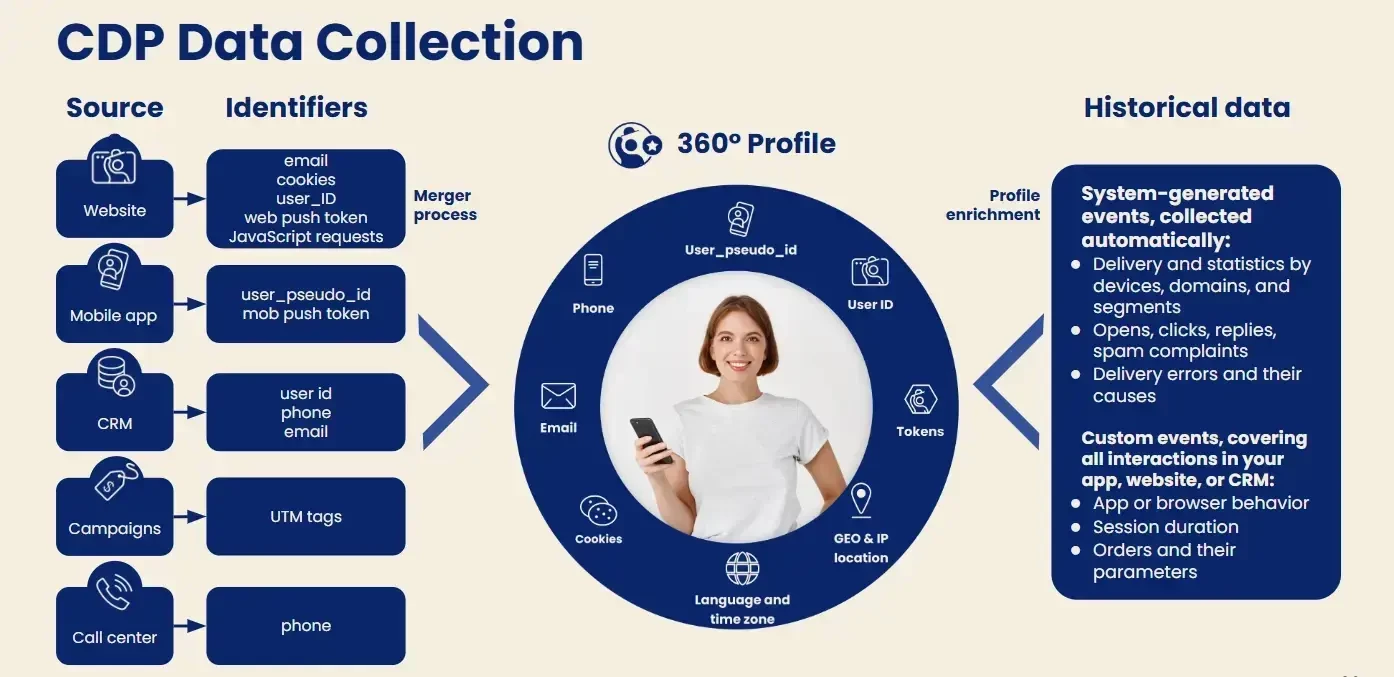
This is not just a database. It is a system that updates in real time and allows seeing the customer not fragmentarily, but holistically. Thanks to this, omnichannel communication becomes not only possible but also practical.
A CDP enables you to:
- coordinate messages across channels so they are not duplicated or contradictory;
- launch personalized workflows based on customer behavior, interests, and status;
- react in the moment when a person is truly ready to engage with the brand;
- build dynamic segments that update automatically;
- see the complete interaction history with each customer and create personalized journeys;
- connect third-party systems (CRM, DMP, analytics, databases) without losing the integrity of the profile;
- use data for analytics, personalization, recommendations, and triggers within a single platform;
- manage the entire communication system from a single interface without involving a technical specialist
This is why a CDP is not just another marketing tool, but a foundation without which marketing loses control, perspective, and results.
Communication Channels in the Omnichannel Structure
Each channel has its own rhythm, tone, and audience expectations. Some work better for quick responses, while others for deeper engagement. The same message can perform differently depending on where and how it is delivered.
For communication to be effective, it’s important to have access to all channels and understand how and when to use each one.
The table below provides a brief overview of the strengths of the main channels and tips on when they work best.
| Channel | Requires Recipient Subscription | Advantages | Disadvantages | When to Use |
|---|---|---|---|---|
| Yes | High ROI, extensive analytics, flexible format, AMP support, large content area | Spam filters, high competition for attention | For regular communication, offers, and triggers | |
| Widgets | No | Interactivity, flexible appearance | The audience may ignore widgets if the display conditions aren’t well thought out | To attract attention to the site and collect data |
| Web Push | Yes | Works even when the website page is closed | Format limitations are annoying when overused | When you need to bring the user back to the site after interaction |
| Mobile Push | Yes | Instant access, high engagement, and reaction to app activity | May be ignored due to oversaturation with other notifications | For a quick return to the app, response to activity |
| In-App | No | Context-bound, integration with app actions | Not saved, can’t return after closing | During app usage - for tips, reminders, engagement |
| App Inbox | No | Can return to the message, non-intrusive | May be ignored | When it’s essential to leave a message that can be viewed later |
| Viber | No | Fast delivery, high open rates | Minimum mandatory payment - €204.77 | Fast delivery of important messages with images, convenient for promotions |
| Telegram Bot | Yes | Conversational communication, quick reaction to user actions | Requires resources for bot development | For more complex workflows or two-way interaction |
| SMS | No | High deliverability regardless of the internet | Minimal text volume | For critically important and urgent messages |
The secret to an omnichannel strategy’s success is the combination of channels that will allow you to reach your audience and optimize your marketing budget. Typically, omnichannel chains are built from the most affordable channels (email, web push, mobile push, etc.) at the beginning and end with more expensive ones (for example, Viber, Telegram, or SMS).
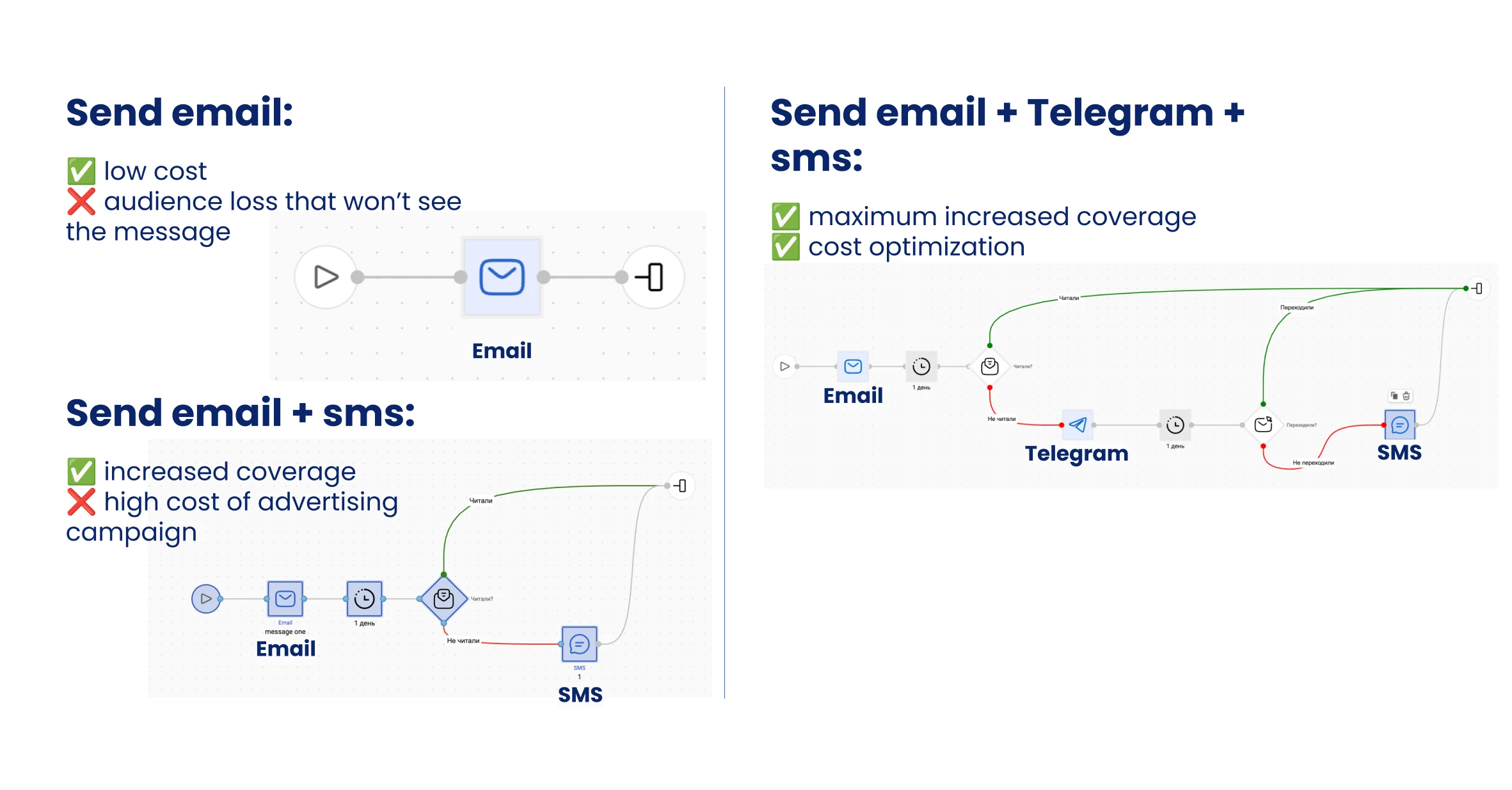
Scaling Сustomer Experience
As soon as the contact base, number of products, directions, and teams grow, manual communication control becomes a bottleneck. It’s impossible to maintain dozens of workflows, correctly set priorities, account for each customer’s behavior, and respond to their actions promptly. Automation solves these tasks and allows scaling interactions without compromising quality.
Automated campaigns work around the clock. They don’t get tired, forget, or make mistakes. The corresponding workflow is triggered as soon as the system receives data that meets the specified conditions: a reminder about a viewed product, reactivation after a pause in communication, recommendation for the next purchase, and so on.
Automation in a CDP encompasses more than just sending messages. It also includes real-time segment updates, campaign planning and generation, A/B testing, and complex workflows with multiple channels and conditions. This allows the customer to respond exactly when they are ready to engage—not earlier, not later.
Automate communication effortlessly
But automation does not replace the marketer. It takes over routine tasks, but still requires a person who:
- identifies which events are essential for triggering workflows;
- sets logic and constraints;
- controls the sequence of communications;
- analyzes results and adjusts strategies.
This is an approach that allows marketing to scale without losing quality:
- working with thousands, or even millions, of contacts as if they were individual customers;
- covering more touchpoints—in a coordinated and relevant way;
- seeing what truly works, thanks to transparent analytics;
- quickly making changes at the level of a single element, rather than the entire campaign.
Conclusion
Omnichannel is no longer an option. It is a new foundation, without which marketing loses connection with the target audience. People switch between channels quickly and unpredictably, so communication becomes invisible if it does not adapt to this movement.
It’s not enough to be everywhere to remain noticeable and relevant. You need a system that sees the customer journey, picks up their actions, and continues the conversation where they left off—no repeats, delays, or loss of logic.
Want to see how this would work for your business? Fill out the form below and get a personalized consultation with examples of solutions that are already delivering results in your niche. No templates. Only what works specifically for you.


